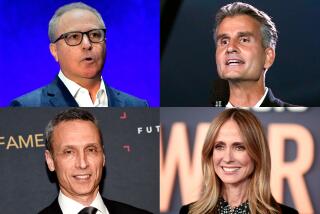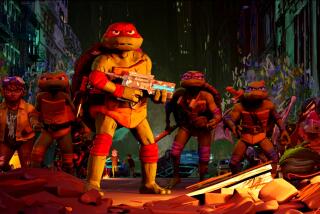Meet the man behind the menu
Devon Downs
âI think DVD menu guy is a pretty good title.â
Credits: âTransformersâ -- plus âalmost every Paramount title in the last seven years, and I probably did another couple of hundred at Universal in the late 1990s.â
Employer: Works for a company called 1K Studios, which is the creative house for the DVD menus for Paramount. âIt got to the point where DVDs had matured so that they wanted somebody at Paramount full-time to facilitate the creative process and get everything through the system. I came over in December 2000.â
The big picture: âMy creative philosophy is that the menus kind of set the table for the film. They create a mood, a kind of feel, so before the person watches a film they get a sense of it. It just enhances the user experience.
âThe other key component of it is that it has to be easy-to-navigate and readable. One of the challenges is to make sure that everything looks as good as possible no matter what kind of TV one has. We test them on different monitors as we are going through different processes.â
Lead time: âFor âTransformersâ we started having initial talks about six months before the movie came out theatrically. The studio was very much involved with director Michael Bay up front and getting feedback.â
The process: âWe have a whole design team over at 1K and a producer is assigned over there that I work with who then works with the designers and animators. We will have a kick-off meeting where we kind of discuss different creative concepts, and Iâll kind of supply the creative direction for different titles based on my conversations with the different people at Paramount. Our designers will storyboard out three to five different animated menu concepts, and then Iâll bring that back to Paramount and present that to the creative team. The creative team will make a selection and then they will present that to marketing and marketing will have feedback or sign off on it.
âOnce we get concept or a look selected, we will go and animate it. Then weâll submit that to the creative team who looks at it with marketing and if everyone agrees, then it goes to outside talent, if there is outside talent involved on a particular project, like the director or producer.â
But wait, thereâs more: âWe get the menus designed and then we have to prep all the menus to the authoring labs, we deliver them to the lab, and they program everything. Then we have to work with them because something might change, like the name of a special feature, or we might have to do a revision.â
Many territories: âItâs an interesting job for a lot of reasons because with DVD menus it crosses many different departments inside of Paramount. It is not only a creative exercise, it is a marketing exercise and a technical and an operational exercise, and then it has legal implications in there as well. I hit all different departments.â
The post-sale advantage: The really nice thing about menus is that because it is post-purchase, you definitely have a lot more creative leeway. We are not trying to sell the disc based on the menu because you already bought the disc.â
Problem solving: âIn essence, a director or a producer might have a specific vision or might supply us with a specific piece of material that they want executed for the menus, but the way itâs described wonât necessarily make a great interface. A lot of times we need to find creative solutions to take that idea and implement it in the best way possible for a menu use.â
Background: âI was on the TV show âExtraâ back in the mid-â90s as a music coordinator. The publicist from âExtraâ had gone to Universal and given me a call and said they had a manager position open and would I want to interview for it.
âThis was in the DVD department. No one knew what DVD was at that time. When I interviewed for the job there I had never seen a DVD.
âAt Universal I worked on packaging, advertising as well as DVD menus. At Universal, one of the vendors they were using was 1K Studios. I left Universal in 1999 because I wanted to be a rock star. I was able to get a small music publishing deal and I was able to live off of that for a year. Then I went to DirectTV as a freelancer, and while I was there I got a call from Matt Kennedy [CEO and creative director of 1K], who said, âYou are the only person we know who doesnât work at a studio, but has worked for a studio and has done DVD menus. We have this unique position where you would be at Paramount.â I gave my notice that day, and that was seven years ago.â
Age: 33
Resides: Sherman Oaks
Union or Guild: None
-- Susan King
More to Read
The biggest entertainment stories
Get our big stories about Hollywood, film, television, music, arts, culture and more right in your inbox as soon as they publish.
You may occasionally receive promotional content from the Los Angeles Times.











